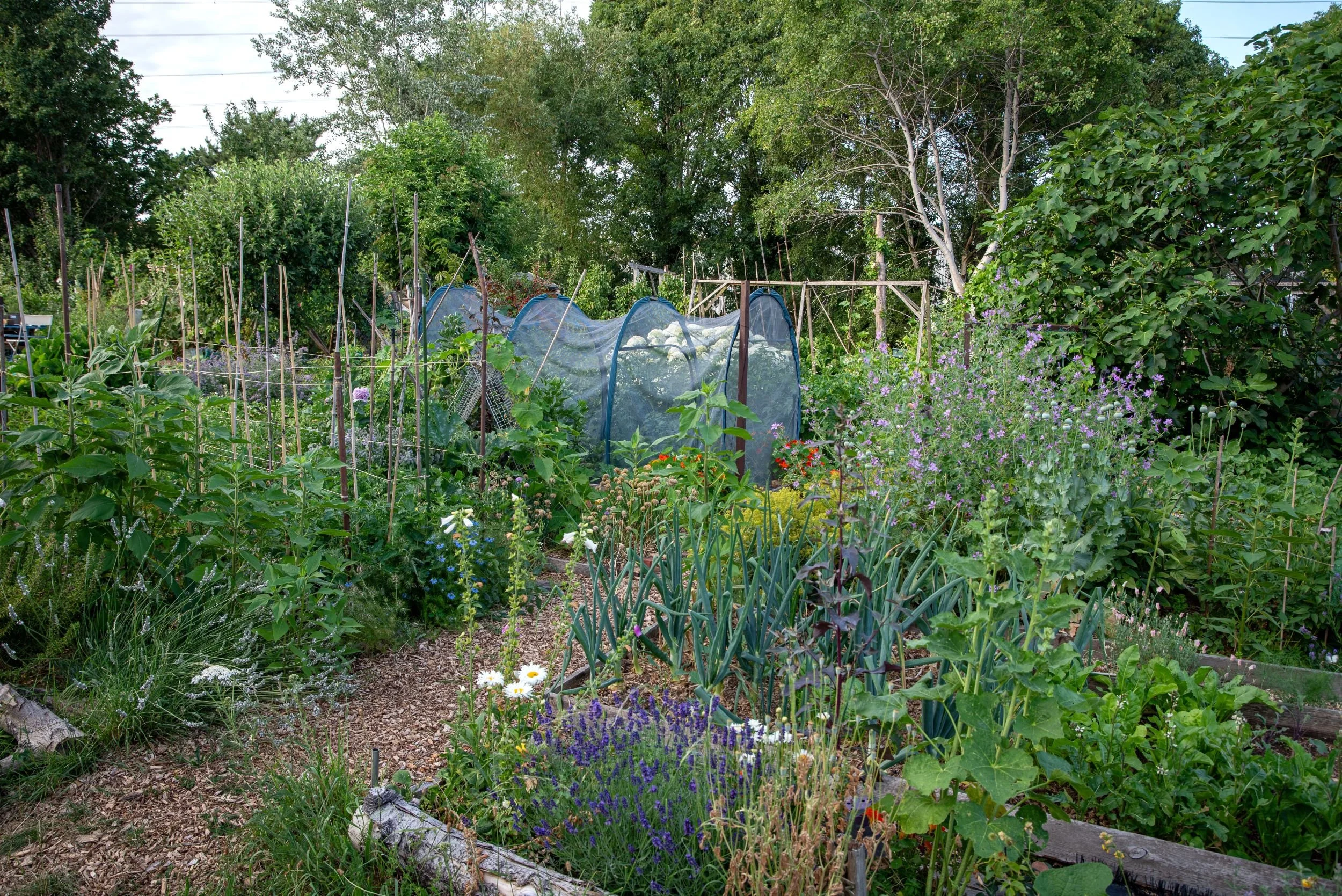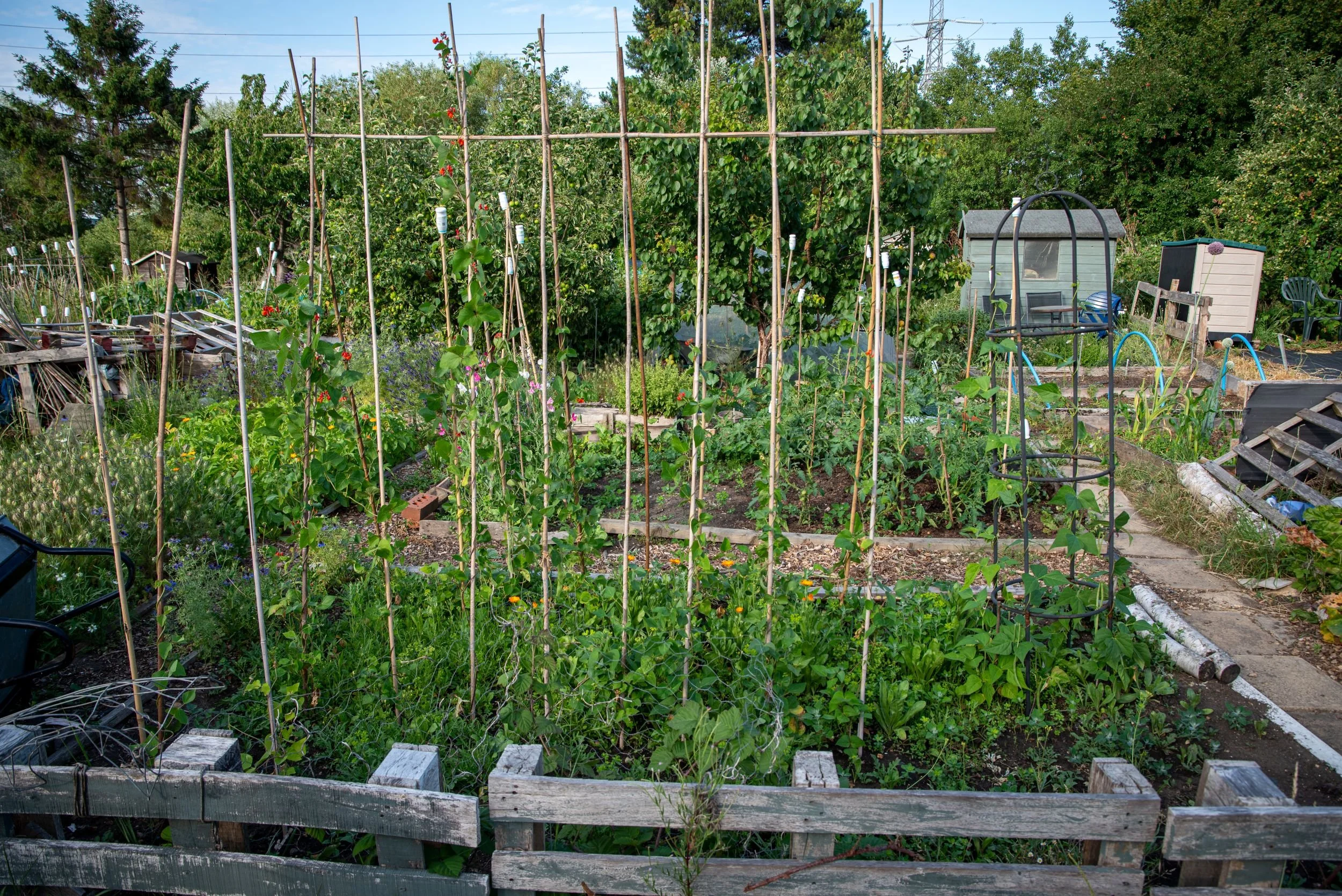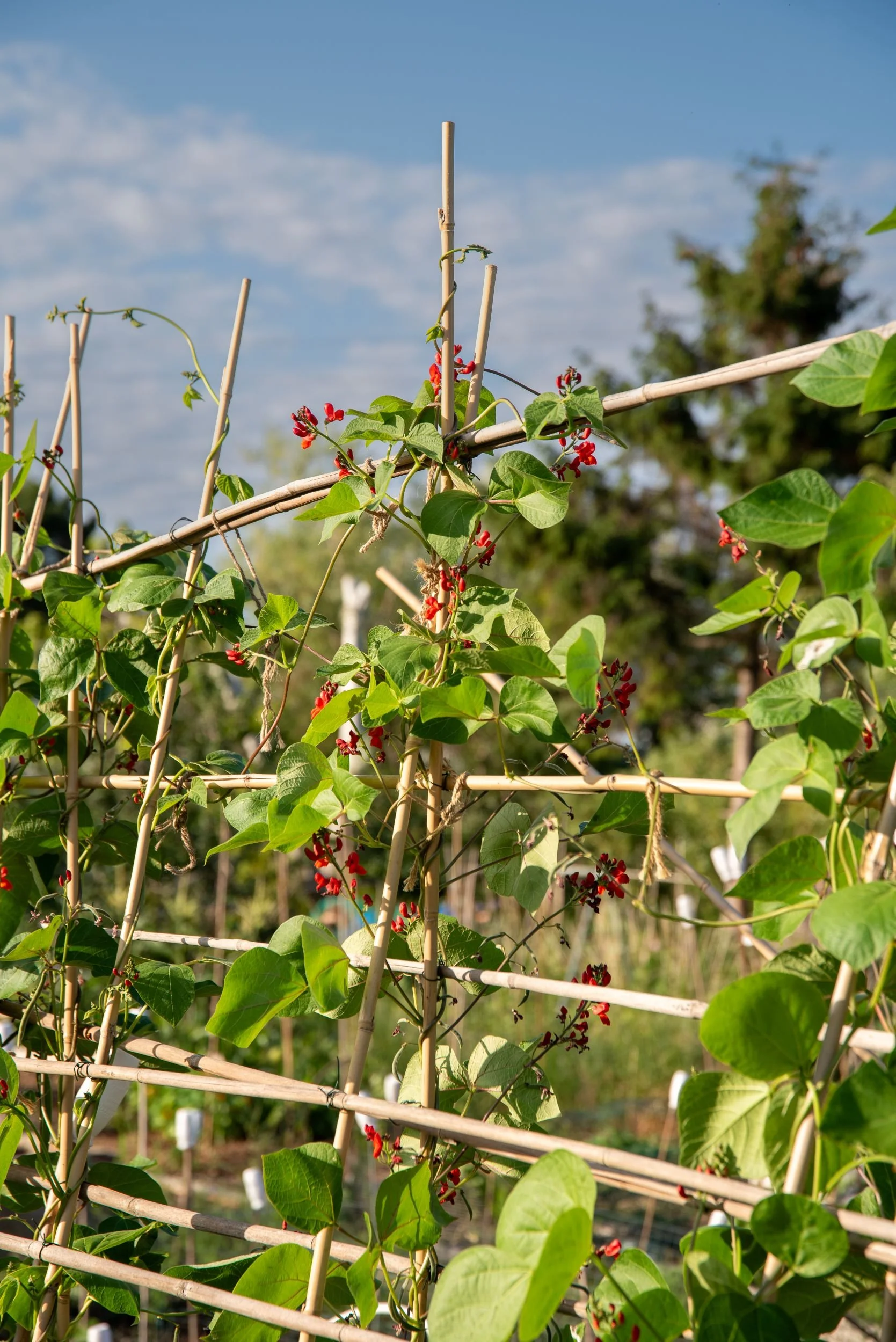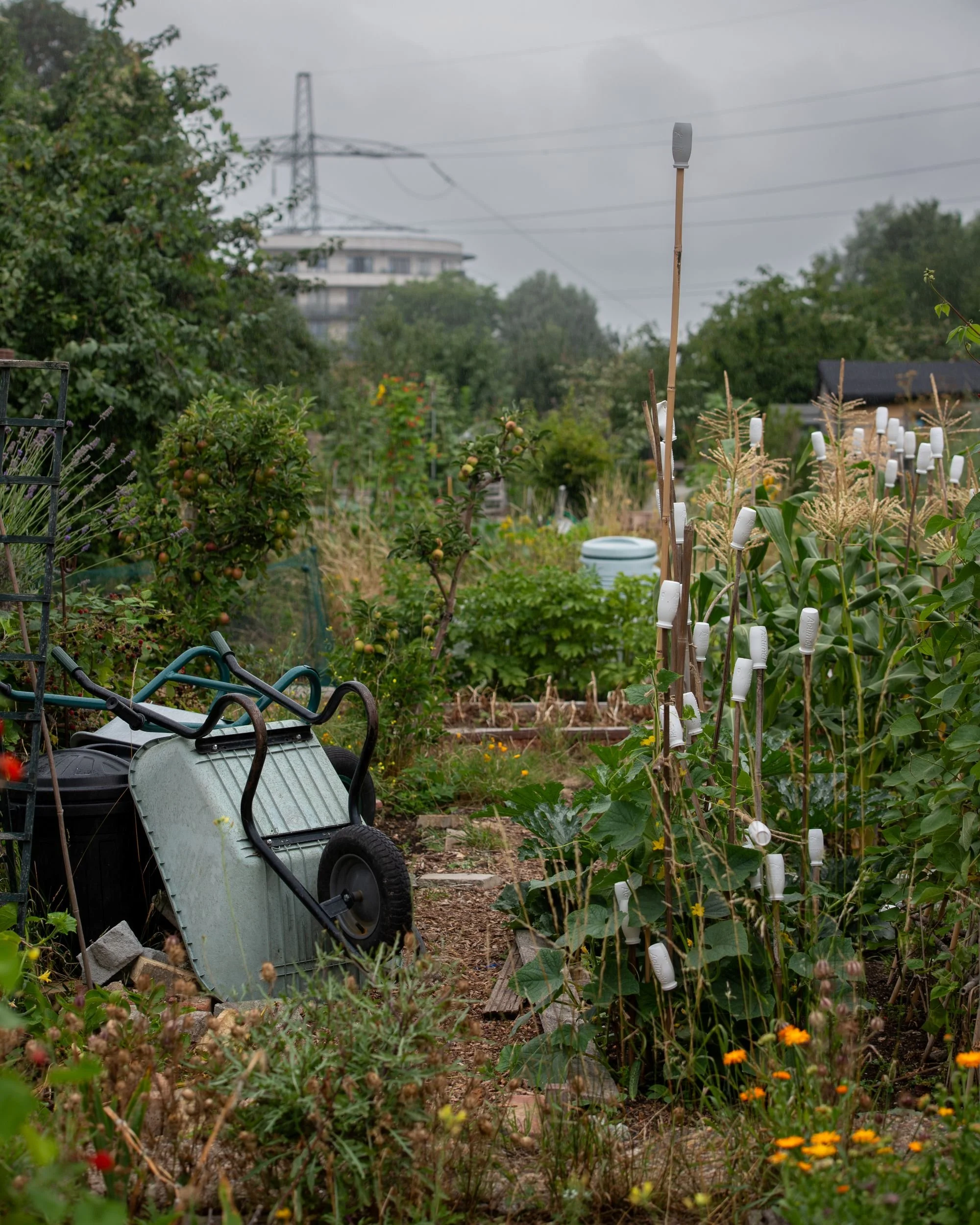The joy of allotmenteering
Every summer our group of park gardening volunteers organises a walking tour of some of our own gardens. This summer we visited two allotments gardened by three of our group.
Allotments seem to be a uniquely British institution. Small areas of land are rented, usually from the local council, to grow fruits, vegetables and plants. Some people keep bees and hens and grow flowers for cutting. Allotments can vary in size but usually measure ten rods or poles, which is around 250 square metres.
Allotments have their origins in the late Anglo-Saxon/early medieval period when large fields were divided into thin strips for individuals or families to grow crops. This was known as the open-field system.
By the late 1500s these fields were divided up to be used only by the owner. They were then enclosed through a series of Acts of Parliament. In compensation, ‘allotments’ of land would be attached to tenant cottages - the first written reference to allotments in the UK.
Allotments as we know them today stem from the General Enclosure Act of 1845 that made provision for ‘field gardens’ to be used by the landless poor—although very little enclosed land was actually set aside for this purpose. The later ‘Small Holdings and Allotments Act’ of 1907 and 1908 imposed responsibilities on councils to provide allotments if there was a demand for them.
There was a huge increase in allotment use during the First and Second World Wars due to the shortage of imported food. Disused railway land, public parks and private gardens were all used to grow fruit and vegetables. The ‘Dig for Victory’ in the Second World War produced 1.3 million tonnes of food from 1.5 million allotment plots.
There was a steady decline in allotment use after the wars but this slowed during the 1970s when TV shows like the BBC’s The Good Life inspired interest in food production and self-sufficiency.
Since the 1990s, there has been a lot of renewed interest with concerns about climate change and foodprovenance, and the benefits of spending more time outside means that demand has rapidly oustripped supply.
The waiting list for the allotments in these photos can be up to eight years. Increasingly there is pressure to change the use from allotments to housing. Recently there has been an increase in the number of private allotments. The cost of these is significantly higher than council-owned ones.
In Merton there are only three council owned allotments and new applications are no longer being accepted. From the statistically insignificant sample of the one allotment site I visited I would say around 20% of the allotments looked they had been abandoned.
It seems to take a long time for these to be declared available for new users. Allotments can deteriorate quickly, becoming invaded with pernicious weeds (and wildlife). It can take six months of hard slog to clear the ground of brambles, bind weed, even himalayan balsam, requiring a lot of determination to keep going.
On the plus side you may inherit established perennial plants such as fruit trees and currant bushes. You may also inherit the shed (every allotment has one) in any state of repair, and assorted accumulated allotment accoutrements such as old baths, gazillions of bamboo poles, untold plastic pots but also greenhouses, paths, edging and well-rotted compost.
Many people take on allotments as they’d like to grow their own food. However, it is apparent that the community of allotmenteers keeps people going. There is lots of advice (whether you want it or not), community get togethers and community resources to share (the wild blackberries and large manure heap here spring to mind).
To the causal observer allotments can look a bit of a mess. Allotmenteers are nothing if not thrifty and resourceful, making use of many household items that might otherwise be thrown away. However, they are also havens of peace and quiet, full of wildlife (mostly welcome…) and provide a much needed escape from urban life.
Long live allotments!
Waterperry Gardens
Waterperry Gardens, in Oxfordshire, is a veritable cornucopia of all things horticultural, edible, cultural and shoppable. The gardens themselves are extensive and would need a visit of several hours to do them justice.
The Truth Trail
The Gardens rose to fame in the middle of the 20th century as a residential horticultural college for women run by Beatrix Havergal (allegedly the inspiration for Roald Dahl’s Miss Trunchbull). The college closed on the death of her life and business partner, Avice Sanders, in 1971.
The Herbaceous Border
Beatrix and Avice originally founded the school in 1921 at Pusey House in Oxfordshire and moved to Waterperry Gardens in 1932. At the time it was rented from Magdelen College.until they bought it in 1948. All students paid their own fees until 1958, when scholarships were granted by some county councils. The diploma was accepted as one equal to those issued by Kew and Edinburgh. Beatrix was awarded an MBE in 1960 and the Royal Horticultural Society Veitch Memorial Medal and Victoria Medal of Honour in 1965. For many years Beatrix won gold medals for her strawberries at Chelsea Flower Show.
The Herbaceous Border
The property was bought by The School of Philosophy and Economic Science in 1971. Beatrice and Avice’s garden has been maintained as they knew it and it has also been extended in scope and content, although it is not clear what is original and what is new.
The canal
The gardens are large and quite varied. You are guided into the gardens along the Truth Trail, over a bridge and through light woodland. Under another bridge the long herbaceous border suddenly appears. It is banked up on oneside alllowing plants to tower over the pedestrian.
Silent Space
The Formal Garden was created by Bernard Saunders and Mary Spiller, a former student and then tutor at Waterperry Horticultural School. The sculpture, Girl holding the Lamp of Wisdom, is by Nathan David. It is a Silent Space, part of a network of gardens of where people can be silent and switch off from the outside world and to take time to reflect.
The Colour Border
The Colour Border
I particularly enjoyed the Colour Borders - these colour co-ordinated mixed borders make use of perennials, shrubs, bedding and bulbs to give all year round colour and interest.
Modern Border
Modern Border
The Modern Borders look good at the end of summer with grasses and later flowering perennials. The wavy edges are reminiscent of the 1970s.
Walled Garden
Walled Garden
Walled Garden
The Georgian Walled Garden has been recently made over as a cutting garden. The deep borders of Dahlias are pretty spectacular as are the beds of colourful annuals. I managed to miss The Mary Rose Garden, Yew Henge and orchards - more to see on another visit, perhaps in the spring.
Beyond the gardens there is a nursery, shops of varying descriptions, art gallery, museum, cafe and outdoor theatre. I didn’t have time to try the cafe. It would be worth taking a picnic as its a long walk to the cafe if you want refreshments part way through your visit.
The kitchen garden at Chatsworth
If there's ever a place to get kitchen garden envy, it's got to be at Chatsworth House. First off, it's huge. Secondly, there are three full-time gardeners. A stream runs through it, good enough to bottle and sell (and they do), more greenhouses than you can shake a stick at and oh, there's the view...
This bench, at the top of the west-facing sloping kitchen garden, has a good view of the two and a half acres, the top of Chatsworth House and the stable block and the Capability Brown landscape on the other side of the River Derwent. But I didn't think to take a photo of all that, you've just got to take my word for it.
(By the way, my most hated combination of colours is pink, yellow and turquoise, but somehow it seems to work here.)
Like all good kitchen gardens, there are a lot of flowers, grown principally for cutting. Some are also grown as companion plants for the fruit and vegetables. These Sweet William were at their peak in late June (the season seems to be a couple of weeks behind SW London).
The Delphiniums were perfect, no slug damage and no stakes. I think Delphiniums are at their most striking just before the flower buds open completely.
I had never considered Foxgloves as possible cut flowers, but why not? Plus, the bees love them, great for helping to pollinate the fruit and veg.
And I've never seen such amazing Peonies in such huge quantities before. These look like Buckeye Belle and Felix Crousse, completely OTT and perfect for midsummer.
Around the edge of the kitchen garden there were stone walls, Yew hedges and odd wildflower invaders, like this Dog Rose. You wouldn't weed this out would you?
The heart of the kitchen garden though is the fruit and vegetable area. All the produce goes straight to the house. The large greenhouses keep the house supplied with grapes, melons, lemons and even fresh ginger. The cold frames ensure salads have an early start.
And of course it wouldn't be a kitchen garden without the head gardener's bothy. This one has been preserved from WWII, complete with a copy of Dig for Victory, an old stove, terracotta pots and string. All gardeners need string.
The herb garden is extensive and contains interesting varieties like banana mint which tastes nothing like banana or mint. This Thyme was nice though.
Did I mention the Delphiums were good?
So, I know you're dying to know how the tea and cake were. Frankly, your best bet is to buy the cake from the Chatsworth Farm Shop (and the rest of your picnic as well - I can recommend the filled rolls and the Scotch Eggs deserve a special mention) and take a flask of your own tea. The garden is huge (we were there for four hours and didn't see it all). The Farm Shop stuff is much better (and cheaper) than anything they sell at the house, and the queues are shorter.
Next month - That trout stream - did Dan Pearson's Chelsea garden do it justice?
Chatsworth House - http://www.chatsworth.org/
The Farm Shop - http://www.chatsworth.org/plan-your-visit/shop-and-eat/chatsworth-estate...
The visit to Chatsworth House was at the end of a fab weekend with Desna, Rob, Sarah and Logan the dog.






































